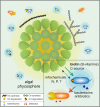Phytoplankton consortia as a blueprint for mutually beneficial eukaryote-bacteria ecosystems based on the biocoenosis of Botryococcus consortia
- PMID: 33462312
- PMCID: PMC7813871
- DOI: 10.1038/s41598-021-81082-1
Phytoplankton consortia as a blueprint for mutually beneficial eukaryote-bacteria ecosystems based on the biocoenosis of Botryococcus consortia
Abstract
Bacteria occupy all major ecosystems and maintain an intensive relationship to the eukaryotes, developing together into complex biomes (i.e., phycosphere and rhizosphere). Interactions between eukaryotes and bacteria range from cooperative to competitive, with the associated microorganisms affecting their host`s development, growth and health. Since the advent of non-culture dependent analytical techniques such as metagenome sequencing, consortia have been described at the phylogenetic level but rarely functionally. Multifaceted analysis of the microbial consortium of the ancient phytoplankton Botryococcus as an attractive model food web revealed that its all abundant bacterial members belong to a niche of biotin auxotrophs, essentially depending on the microalga. In addition, hydrocarbonoclastic bacteria without vitamin auxotrophies seem adversely to affect the algal cell morphology. Synthetic rearrangement of a minimal community consisting of an alga, a mutualistic and a parasitic bacteria underpins the model of a eukaryote that maintains its own mutualistic microbial community to control its surrounding biosphere. This model of coexistence, potentially useful for defense against invaders by a eukaryotic host could represent ecologically relevant interactions that cross species boundaries. Metabolic and system reconstruction is an opportunity to unravel the relationships within the consortia and provide a blueprint for the construction of mutually beneficial synthetic ecosystems.
Conflict of interest statement
The authors declare no competing interests.
Figures





References
-
- Grosberg RK, Strathmann RR. The evolution of multicellularity: a minor major transition? Annu. Rev. Ecol. Evol. Syst. 2007;38:621–654. doi: 10.1146/annurev.ecolsys.36.102403.114735. - DOI
-
- Cole JJ. Interactions between bacteria and algae in aquatic ecosystems. Annu. Rev. Ecol. Syst. 1982;13:291–314. doi: 10.1146/annurev.es.13.110182.001451. - DOI
Publication types
MeSH terms
LinkOut - more resources
Full Text Sources
Other Literature Sources

